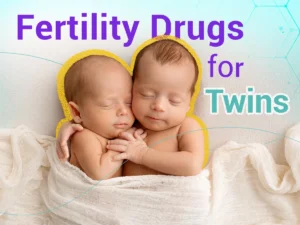
Fertility treatments have revolutionized the way couples struggling with infertility can achieve their dreams of parenthood. While in vitro fertilization (IVF) is widely known for helping individuals conceive, fertility drugs are another avenue that many couples explore, particularly when it comes to increasing the likelihood of having twins. Fertility drugs, when used under careful supervision, stimulate ovulation, potentially leading to multiple eggs being released and resulting in a multiple pregnancy, including twins.
For many people, the prospect of having twins can be an exciting idea. However, fertility treatments that increase the chances of having twins must be approached with caution and awareness of the potential risks. While fertility drugs can help in some cases, they may also result in complications, making it essential to understand their mechanisms, the factors influencing the likelihood of twins, and the health risks involved.
What Are Fertility Drugs for Twins and How Do They Work?
Fertility drugs are medications used to enhance the chances of conception by stimulating the ovaries to produce eggs. These drugs are primarily prescribed for women who have difficulty ovulating on their own, which is a common cause of infertility. In the context of a twin pregnancy, fertility drugs can lead to the release of multiple eggs, increasing the chance of having more than one embryo implanted, ultimately resulting in twins.
1. Understanding Ovulation Stimulation and Twin Pregnancy
Ovulation is the process which a mature egg is released from the ovary and makes its way down the fallopian tube, where fertilization can occur. Usually, only one egg is released per menstrual cycle. However, with the use of fertility drugs, the goal is to stimulate the ovaries to release multiple eggs. When two or more eggs are released during ovulation, there is a higher chance that more than one egg will be fertilized and successfully implanted in the uterus, resulting in a twin pregnancy.
Ovulation-stimulating medications, such as Clomid, Letrozole, or gonadotropins, work by regulating the hormones responsible for egg development and release. These drugs increase the likelihood of multiple eggs being produced during one cycle, which in turn raises the probability of multiple embryos forming and developing into twins or higher-order multiples.
2. Types of Fertility Drugs That Can Lead to Multiples
Several types of fertility drugs are commonly used to promote ovulation and increase the likelihood of twins. These drugs fall into two main categories: oral medications and injectable hormones.
- Clomiphene Citrate (Clomid): Clomid is one of the most commonly prescribed medications for women with ovulatory dysfunction. It works by stimulating the pituitary gland to produce more follicle-stimulating hormone (FSH), which promotes the growth of eggs in the ovaries. Clomid is typically used for women with irregular cycles or ovulation problems and is known to increase the chance of twins, particularly if used at higher doses.
- Letrozole (Femara): Letrozole is often used off-label for fertility treatments. Similar to Clomid, it works by inhibiting estrogen production, thereby increasing FSH levels and stimulating the ovaries to release more eggs. Research has shown that Letrozole can also lead to a higher chance of twin pregnancies, though it is typically preferred in cases where Clomid has not been effective.
- Gonadotropins: These injectable medications contain FSH and sometimes luteinizing hormone (LH) and directly stimulate the ovaries to produce multiple eggs. Gonadotropins are often used in conjunction with intrauterine insemination (IUI) and have a higher success rate for producing twins compared to oral medications like Clomid or Letrozole.
3. Who Is a Good Candidate for Fertility Drugs for Twins?
Fertility drugs for twins are typically prescribed to women who have difficulty ovulating or have conditions like polycystic ovary syndrome (PCOS). The goal of these medications is to stimulate the ovaries to produce multiple eggs, increasing the likelihood of conception. Women with unexplained infertility or those who have had failed attempts with other fertility treatments may also be candidates for fertility drugs that increase the chances of having twins.
However, fertility drugs should be used with caution. A thorough evaluation by a fertility specialist is crucial to determine whether a woman is a good candidate. This includes testing for hormone imbalances, evaluating ovarian reserve, and ensuring that other fertility issues do not complicate the use of these medications.
How Fertility Drugs Increase the Chances of Having Twins
Fertility drugs increase the chances of having twins primarily by stimulating the ovaries to release multiple eggs during one menstrual cycle. The likelihood of a twin pregnancy depends on several factors, including the type of medication used, the dosage, and the woman’s individual response to treatment.
1. The Role of Hormonal Stimulation in Multiple Ovulation
The most common mechanism by which fertility drugs increase the chances of twins is through hormonal stimulation. Medications like Clomid, Letrozole, and gonadotropins work by increasing levels of follicle-stimulating hormone (FSH) and luteinizing hormone (LH), which promote the growth and maturation of multiple follicles in the ovaries. When multiple follicles develop, there is a greater chance that more than one egg will be released during ovulation, resulting in multiple eggs being available for fertilization.
The stimulation of multiple eggs also increases the likelihood that two embryos will successfully implant in the uterus, leading to a twin pregnancy. The number of eggs that are released can vary from cycle to cycle and depends on the dosage and individual response to the medication.
2. Identical vs. Fraternal Twins: What Fertility Drugs Influence
When twins are conceived through fertility treatments, they can be either fraternal (dizygotic) or identical (monozygotic). Fertility drugs like Clomid and gonadotropins primarily increase the chances of having fraternal twins, where two separate eggs are fertilized by two different sperm cells, leading to two embryos developing.
In contrast, identical twins occur when a single fertilized egg splits into two separate embryos, resulting in genetically similar individuals. While fertility drugs are more likely to induce fraternal twins by promoting multiple egg release, they do not directly influence the likelihood of identical twins. The occurrence of identical twins is more random and is not typically affected by fertility treatment.
3. Factors That Affect Your Chances of Having Twins
While fertility drugs can increase the likelihood of twins, several factors influence how likely it is that a woman will conceive twins. Age is one of the most significant factors, as women under 35 are more likely to have twins than older women. Additionally, the number of eggs produced and the woman’s response to fertility drugs also play a role.
Women who have had twins in the past, those with a family history of twins, and women with higher body mass index (BMI) may also have a higher chance of conceiving twins when using fertility drugs. The type of fertility medication used and the specific treatment plan will also influence the outcome.
Are Fertility Drugs for Twins Safe? Risks and Side Effects
While fertility drugs can significantly increase the chances of conception, they also come with certain risks. It’s essential to understand both the benefits and potential downsides before starting fertility treatment.
1. Common Side Effects of Ovulation-Stimulating Medications
Ovulation-stimulating medications can cause several side effects, some of which can be uncomfortable or alarming. The most common side effects include bloating, abdominal discomfort, mood swings, hot flashes, and headaches. These side effects are often temporary and typically resolve once treatment is completed, although they can be bothersome during the treatment period.
More serious risks include ovarian hyperstimulation syndrome (OHSS), a condition where the ovaries become swollen and painful due to overstimulation. While rare, OHSS can cause complications such as dehydration, blood clots, and difficulty breathing.
2. Risks of High-order Multiple Pregnancy
One of the most significant risks associated with fertility drugs for twins is the possibility of a high-order multiple pregnancy, which occurs when three or more embryos implant in the uterus. High-order multiple pregnancies carry greater risks for both the mother and the babies, including preterm birth, low birth weight, and complications during delivery. Fertility specialists usually monitor patients closely to minimize this risk and may recommend reducing the number of embryos transferred to reduce the likelihood of a high-order pregnancy.
3. How to Minimize Health Risks with Medical Supervision
To ensure the safe use of fertility drugs, women undergoing treatment should be carefully monitored by a qualified fertility specialist. Regular ultrasounds, blood tests, and close communication with the doctor are essential for tracking ovarian response, ensuring the proper dosage of medication, and preventing complications such as OHSS or multiple pregnancies. Fertility specialists may also tailor treatment plans based on individual factors, such as age, ovarian reserve, and health status, to minimize risks and optimize outcomes.
Success Rates of Fertility Drugs for Twins: What to Expect
Success rates for twin pregnancies using fertility drugs vary depending on several factors, including the type of medication used, the woman’s age, and her overall health.
1. Twin Pregnancy Rates by Drug Type (Clomid, Letrozole, Gonadotropins)
- Clomid: Success rates for Clomid vary widely but are generally between 5-10% per cycle for achieving a twin pregnancy. Clomid is typically used for women with ovulatory dysfunction, and while it can result in twins, it’s more likely to lead to a single pregnancy.
- Letrozole: Letrozole has a similar success rate to Clomid but is often considered more effective in women who do not respond to Clomid. The twin pregnancy rate with Letrozole is slightly higher than Clomid, but it still remains relatively low.
- Gonadotropins: Gonadotropins, being injectable fertility medications, have the highest success rates for multiple pregnancies. The twin pregnancy rate with gonadotropins can range from 10-30%, depending on the dosage and treatment plan.
2. Age and Success Rate with Fertility Drugs for Twins
Age plays a significant role in fertility, and women under the age of 35 are more likely to conceive twins with fertility drugs. As women age, their chances of producing multiple eggs decrease, and the success rates for fertility treatments, including those that increase the likelihood of twins, tend to decline.
3. Other Factors Influencing Outcome
Other factors that influence the success rate of fertility drugs for twins include the overall health of the woman, ovarian reserve, and lifestyle factors such as weight, exercise, and smoking. Proper medical supervision and individualized treatment plans are essential for optimizing the chances of achieving a twin pregnancy while minimizing risks.
Final Words
Fertility drugs for twins can significantly increase the chances of conceiving twins, but they come with both benefits and risks. The medications used to stimulate ovulation increase the likelihood of multiple eggs being released, leading to a greater chance of a multiple pregnancy. However, the possibility of high-order multiples and other complications requires careful consideration and medical supervision. It’s essential for women undergoing fertility treatments to have open discussions with their fertility specialists to understand the risks, benefits, and the best course of action for achieving their reproductive goals.
For couples considering fertility treatments that may lead to twins, it is essential to weigh the emotional, physical, and financial aspects of the journey. With the proper guidance and support, fertility treatments can help fulfill the dream of starting or expanding a family. Still, a thoughtful approach to treatment options is crucial for both maternal and child health.
References
- American Society for Reproductive Medicine (ASRM). “Clomiphene Citrate for Ovulation Induction.”
- National Institute for Health and Care Excellence (NICE). “Fertility: Ovulation Stimulation.”
- Fertility and Sterility Journal. “Impact of Gonadotropins on Ovulation and Pregnancy Rates.”
- WebMD. “Letrozole (Femara) for Fertility Treatment.”
